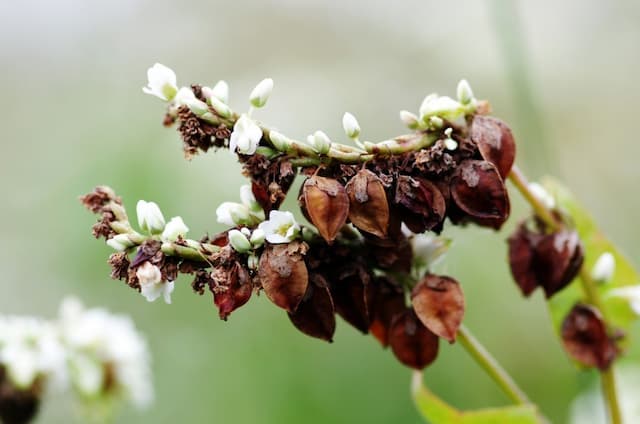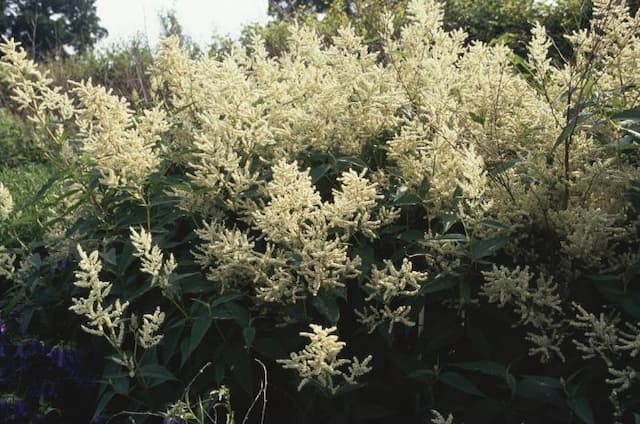Himalayan Bistort Persicaria affinis 'Darjeeling Red'

ABOUT
Darjeeling Red is a carpeting plant known for its attractive foliage and flowers. The leaves are oval-shaped and somewhat elongated, boasting a deep green hue that sometimes transitions to bronzy-red during the colder months, providing a hint of year-round interest. The flower spikes emerge above the foliage in summer, carrying dense clusters of tiny, bell-shaped flowers. The blooms start out a light pink shade and gradually deepen to a striking reddish hue as they mature. This progression of color adds a dynamic aspect to the plant's overall appearance. The flowers are held in a poker-like fashion, which creates a pleasing visual contrast against the lush greenery below. Overall, Darjeeling Red presents a harmonious blend of color and texture, contributing to its popularity in garden landscapes.
About this plant
 Names
NamesFamily
Polygonaceae.
Synonyms
Himalayan Bistort, Fleece Flower, Darjeeling Red, Knotweed.
Common names
Bistorta affinis, Polygonum affine, Persicaria campanulata.
 Toxicity
ToxicityTo humans
The plant commonly known as Himalayan bistort is not typically considered toxic to humans. There are no well-documented cases of poisoning from this plant, and it is not known to possess compounds that are harmful upon ingestion. However, as with any plant material, individual allergies or sensitivities might occur, and it is generally advised not to eat ornamental plants due to potential pesticide exposure or the presence of naturally occurring irritants.
To pets
Himalayan bistort is not generally known to be toxic to pets either. It is not listed among the common poisonous plants for animals such as cats and dogs. As with humans, pets may have individual sensitivities or allergies, and ingestion of plant material could potentially lead to gastrointestinal upset simply due to the ingestion of non-food items. If a pet ingests this plant and shows signs of illness, it is recommended to consult a veterinarian.
 Characteristics
CharacteristicsLife cycle
Perennials
Foliage type
Semi-evergreen
Color of leaves
Green
Flower color
Pink
Height
1 foot (30 cm)
Spread
1-2 feet (30-60 cm)
Plant type
Herb
Hardiness zones
5
Native area
Himalayas
Benefits
 General Benefits
General Benefits- Easy Maintenance: The plant is relatively low-maintenance, thriving in a wide range of soil conditions and requiring minimal care once established.
- Drought Tolerance: Once established, it has good drought tolerance, making it suitable for xeriscaping or areas with low water availability.
- Erosion Control: Its dense growth can help stabilize soil and prevent erosion on slopes or in garden beds.
- Ground Cover: It grows into a dense mat, suppressing weeds and reducing the need for mulching or other ground covers.
- Winter Interest: In mild climates, the plant provides winter interest with evergreen foliage and hues that persist into the colder months.
- Attracts Pollinators: During its flowering season, the blooms attract bees and butterflies, which are beneficial for pollination in the garden.
- Visual Appeal: 'Darjeeling Red' offers a striking display of deep red flowers and can serve as an effective groundcover that provides color and texture to garden designs.
- Fast Spread: The plant is capable of spreading quickly, covering bare spots effectively and adding to the landscape aesthetic.
 Medical Properties
Medical PropertiesThis plant is not used for medical purposes.
 Air-purifying Qualities
Air-purifying QualitiesThis plant is not specifically known for air purifying qualities.
 Other Uses
Other Uses- Persicaria affinis 'Darjeeling Red' can be used as a natural dye, providing hues ranging from soft pinks to rich burgundies depending upon the mordant used.
- The dense mat-forming nature of Darjeeling Red makes it an excellent living mulch, suppressing weeds while retaining soil moisture.
- It serves as a ground cover for erosion control on slopes or in areas where grass might struggle to grow.
- The plant provides habitat and shelter for small wildlife and beneficial insects, such as ground beetles and spiders within garden ecosystems.
- When used in rain gardens, it can help in water management by allowing rainwater to percolate through the soil, reducing runoff.
- Darjeeling Red can be incorporated into sensory gardens; its textured foliage and vibrant flowers can be appealing for tactile and visual stimulation.
- Its flowering habit can be used for educational purposes, such as teaching about pollination and the life cycle of plants.
- When planted in pots, it can be utilized as a spillover plant, where its cascading stems create an aesthetic overhang.
- This plant can be used to create a tapestry-like effect in mixed borders and flower beds due to its dense foliage and flowering habits.
- As a seasonal indicator, the timing of its blooms can signal the onset of summer or fall in temperate gardens.
Interesting Facts
 Feng Shui
Feng ShuiThe Himalayan bistort is not used in Feng Shui practice.
 Zodiac Sign Compitability
Zodiac Sign CompitabilityThe Himalayan bistort is not used in astrology practice.
 Plant Symbolism
Plant Symbolism- Resilience: Persicaria affinis 'Darjeeling Red', commonly known as knotweed, is known for its robustness and ability to thrive in a variety of soil conditions, representing the ability to adapt and persevere through challenges.
- Growth: As knotweed can spread quickly and cover ground, it symbolizes personal growth and expansion.
- Connection: The interconnected root system of the knotweed suggests a symbol of the connections we share with family and friends, emphasizing the importance of building a strong support network.
- Caution: In some species, knotweed can be invasive, therefore it may also symbolize unintended consequences or the need to be cautious about our actions and their impacts on our surroundings.
 Water
WaterThe Himalayan Fleece Flower requires consistent moisture, so water it regularly to keep the soil evenly moist without being waterlogged. During the growing season, especially in dry spells, providing about 1 inch of water per week is sufficient. For potted plants or those in well-drained soils, watering twice a week may be necessary. Reduce watering in winter when the plant is dormant. If rainfall is scarce, check the soil moisture level at least once a week and water accordingly, using gallons as a measure for ease.
 Light
LightThe Himalayan Fleece Flower thrives in full sunlight to partial shade. The ideal location would be a spot that receives several hours of morning sunlight but is protected from the harsh afternoon sun, particularly in hotter climates. Bright, indirect light will also support its growth, ensuring the foliage maintains its vibrant color.
 Temperature
TemperatureThe Himalayan Fleece Flower can survive a range of temperatures but grows best when the weather is between 50°F and 75°F. These plants are hardy down to about -20°F and can tolerate heat up to around 80°F. Avoid placing it in locations where the temperature can dip below this range for prolonged periods to prevent frost damage.
 Pruning
PruningPrune the Himalayan Fleece Flower to remove spent flowers and encourage a second bloom. Lightly trim the plant in the spring to shape it and remove any dead or damaged growth. Annual pruning is usually sufficient, and the best time for a more thorough trim is after the flowering period has ended.
 Cleaning
CleaningAs needed
 Soil
SoilHimalayan Fleeceflower thrives in moist, well-drained soil rich in organic matter; a mix of two parts garden soil, one part compost, and one part sand or perlite works well. The ideal soil pH for this plant is between 6.0 and 7.0.
 Repotting
RepottingHimalayan Fleeceflower does not typically require frequent repotting; it can be done every 2-3 years if the plant has outgrown its container or the soil appears spent.
 Humidity & Misting
Humidity & MistingHimalayan Fleeceflower prefers moderate humidity conditions; it is adaptable but thrives best in environments that mimic its natural mountainous habitat.
 Suitable locations
Suitable locationsIndoor
Place in bright indirect light, ensure good air circulation.
Outdoor
Plant in partial shade, water regularly, protect from strong winds.
Hardiness zone
4-9 USDA
 Life cycle
Life cycleThe life of the plant Persicaria affinis 'Darjeeling Red', commonly known as Himalayan Bistort or East Indian Knotweed, begins as a seed that germinates in moist soil conditions in the spring. The seedling emerges and develops into a vegetative plant, producing a dense mat of foliage with spoon-shaped leaves. Through the summer, the plant enters its flowering stage, displaying spikes of closely packed, small pink flowers that gradually darken to red. After pollination, typically by insects, the flowers produce seeds which eventually fall to the ground or are dispersed by wind and animals, allowing the plant to spread and colonize new areas. In the fall, the foliage often turns to a bronze color, adding seasonal interest to the garden. Himalayan Bistort then enters a period of dormancy during the winter, with its roots surviving underground to regrow in the next spring, continuing its perennial life cycle.
 Propogation
PropogationPropogation time
Spring-summer
Persicaria affinis 'Darjeeling Red', commonly known as Himalayan Bistort or Fleeceflower, is typically propagated through division. The best time to propagate through division is in the spring or early autumn. To do so, gently lift the plant from the soil with a garden fork, being careful not to damage the roots. Once the plant is out, use your hands or a sharp knife to divide the clump into smaller sections, ensuring each section has a good root system and several shoots. Replant the smaller sections immediately at the same soil level they were previously, spacing them about 12 inches (approximately 30 centimeters) apart to allow for growth. Water the new plantings thoroughly to help establish them. This method of propagation is quick and reliable, making it popular among gardeners for expanding their display of the striking, carpet-forming perennial.




![Red bistort [JS Seven Oaks Village]](/_next/image?url=https%3A%2F%2Fplants-admin.emdemapps.com%2Fimages%2Fplants%2F%2Fimages%2F604b56557c0e3.png&w=640&q=75)




